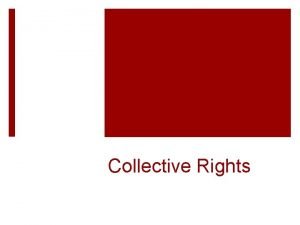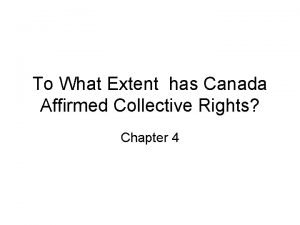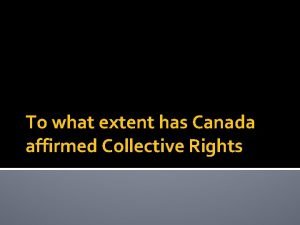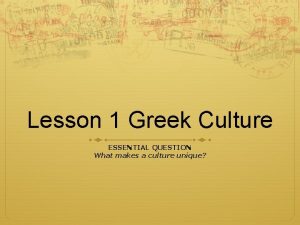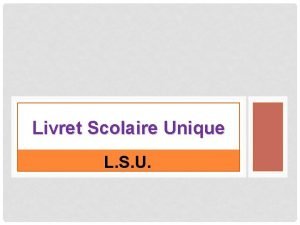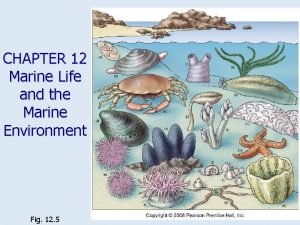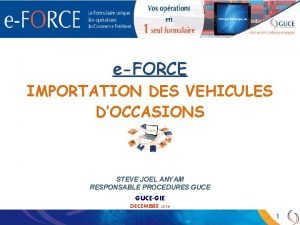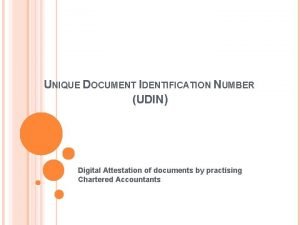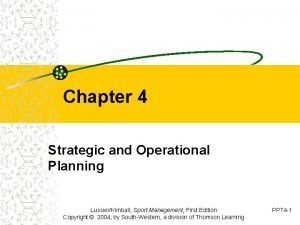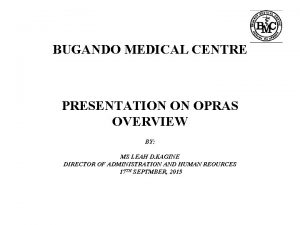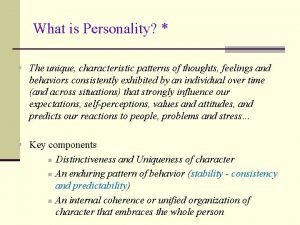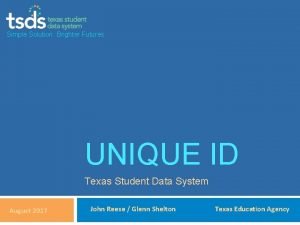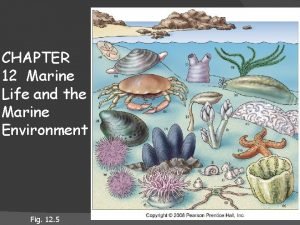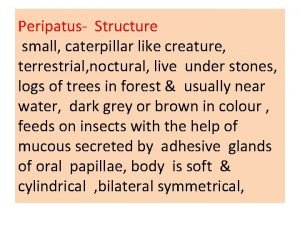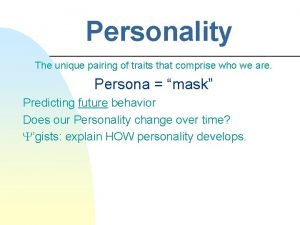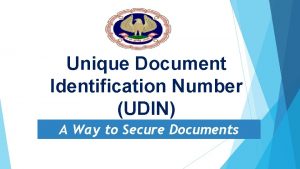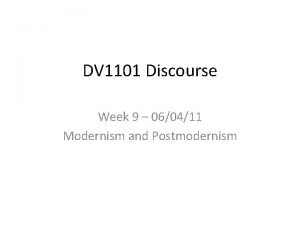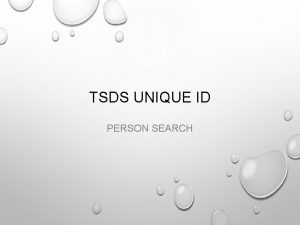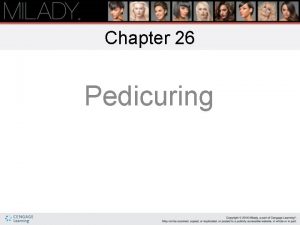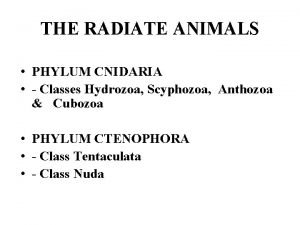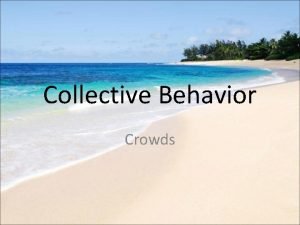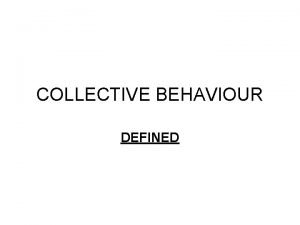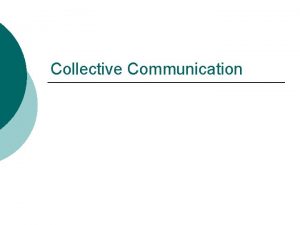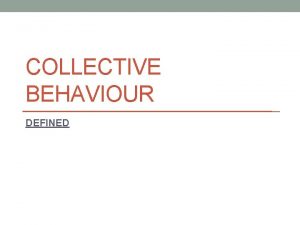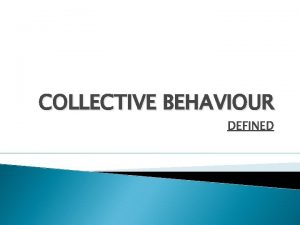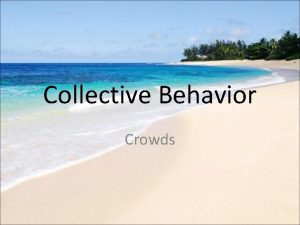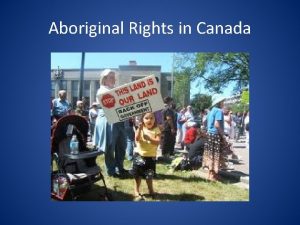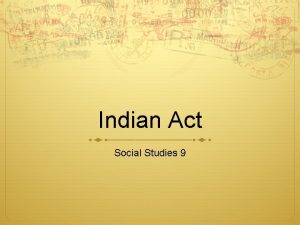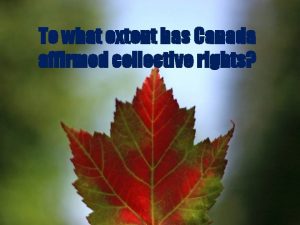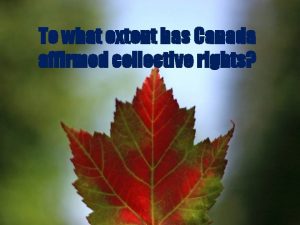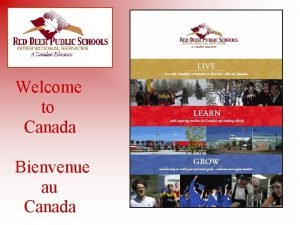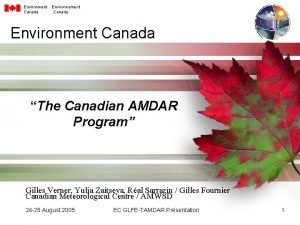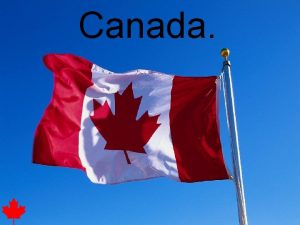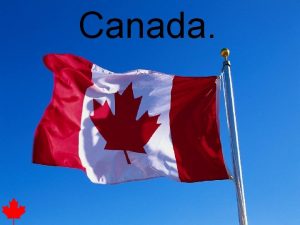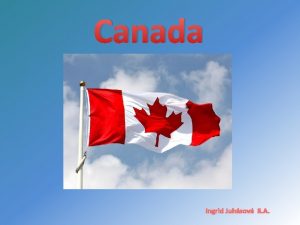Collective Rights What Makes Canada Unique What are






























![Aims of Residential Schools ¡“I want to get rid of the Indian problem. […] Aims of Residential Schools ¡“I want to get rid of the Indian problem. […]](https://slidetodoc.com/presentation_image/463a245026b377881e7c854af48a4e8f/image-31.jpg)





























- Slides: 60

Collective Rights

What Makes Canada Unique? ¡What are some thing that separate Canada from other countries, like the USA?

¡Collective rights and identity are things that make Canada unique ¡Collective rights of groups are protected under the Charter, and no other country has this type of legislation ¡Over time, legislation has acknowledged the collective rights of groups in Canada ¡These legislations have impacted these groups’ sense of belonging and identity What ways do you think legislation can impact belonging and identity?

In this unit, we will learn: ¡What are collective rights? Who do they apply to? ¡How has Canada affirmed collective rights? ¡What laws recognize the rights of First Nations peoples? ¡What collective rights do official language groups have under the Charter? ¡What laws recognize the collective rights of the Métis?

Collective Rights ¡Collective Rights: rights guaranteed to specific groups in Canadian society for historical and constitutional reasons

What do Collective Rights do? ¡They affirm (validate) the collective identity of groups in society and to create a society where people of different identities belong ¡The government officially recognizes a distinct group of people and their rights in the constitution

What do Collective Rights do? ¡Reflects the idea of mutual respect among peoples ¡To preserve the language and culture of minority groups in Canada that were a part of the heritage, foundation, and creation of Canada

What is the difference between Individual and Collective Rights? ¡Every Canadian citizen and permanent resident has individual rights in the Charter ¡Collective rights are rights that Canadians have because they belong to one of several groups in society

Who has Collective Rights? ¡Aboriginal Peoples (First Nations, Metis and Inuit) ¡Francophones and Anglophones

Collective Rights We will look at: ¡Laws that recognize the collective rights of First Nations peoples ¡Collective rights official language groups have ¡Laws that recognize collective rights of the Métis ¡Why do some people have collective rights and not others? (page 122)

• • • Constitution Manitoba Act Modern Treaties Historical Treaties Modern & Historical Treaties Indian Act


Collective Rights ¡Collective rights recognize the founding peoples of Canada ¡Focus Questions: ¡ On page 2 of your workbook, read and highlight the information provided regarding the Numbered Treaties. ¡ Answer the two questions…be ready to participate in a discussion. ¡Using pages 128 -135, fill in the “Perspectives” Chart on page 3 of your workbook

500 Years in 2 Minutes ¡https: //www. youtube. com/watch? v=xm. Yu-Wppp 3 c

The Indian Act ¡The Act is a federal legislation related to the rights and status of First Nations peoples ¡ First passed in 1876 (has been amended several times since) ¡ **amend = change ¡Specific policies to administer Treaty rights ¡ Treaties = Government’s duty to protect collective rights ¡Created “Indian Agents” ¡ Officials who decided how the government would fulfill its duties based on the needs of each individual reserve ¡ This results in many different interpretations (case-by-case) of what a “treaty right” is

The Indian Act ¡Ethnocentrism: The belief that ones culture is superior to all other cultures ¡During times of colonialism, people of European descent were ethnocentric ¡ Canada’s government thought it was OK to make laws for the First Nations without consulting them ¡ Is Ethnocentrism still evident in our world today? ¡The Act allows the government to administer Treaty rights to Treaty peoples ¡ The gov’t says who is a “status Indian”, not the First Nation peoples

The Indian Act ¡The original purpose of the Act was to assimilate First Nations peoples ¡ Assimilate: become part of a different cultural group ¡Within the original version of the Act: ¡ Dictated how to conduct their elections/”government” ¡ Restricted ability to travel freely ¡ Could not take political action ¡ **Until 1960 in order to vote in Canadian elections, they had to give up their “status” (legal identity and treaty rights) ¡ Disallowed traditional dress and ceremonies ¡ While the Act has been amended, it still remains in force today

Changing the Indian Act ¡Read June 14, 2002 article entitled “First Nations vow to battle bill” on page 138 in textbook ¡ Why did the First Nations reject the proposed changes to the Indian Act? ¡ What should be done about the Indian Act today?


Treaties ¡To get started on learning about treaties, we will watch a video from the Office of the Treaty Commissioner about treaties in the west, specifically Saskatchewan. ¡One thing to take away from this, we are all treaty people. A Solemn Undertaking

Treaties ¡Nation to nation agreements. We are involved in the treaties; they cannot be changed.

Treaties ¡The Royal Proclamation 1763: established how First Nations would be governed. Treaties were negotiated ¡As Europeans moved west, land resources were destroyed, thus destroying land animals the First Nations used to survive ¡Thus treaties were created since First Nations could no longer make a living

Treaties ¡Language and translation issues, fraud, foreign legal concepts were all issues when signing treaties ¡Indian Agents assigned to reserves; determined who could leave, decided many aspects of First Nations peoples lives; they had no control

The Numbered Treaties ¡Numbered Treaties are historic agreements that affect the rights and identity of some First Nations ¡Agreements between the Queen and First Nations ¡Lands and resources were shared

Numbered Treaties ¡The treaties are sacred agreements to First Nations; they cannot be changed without their agreement ¡The government believes First Nations gave up their lands in the treaties. However, First Nations don’t see land as something to be “given up” or “own” ¡The government and First Nations versions of treaties differ; First Nations recorded treaties orally, and the government had written records

Numbered Treaties ¡Treaties were negotiated because: Canada wanted to build a railway to connect BC to the rest of Canada First Nations and the government did not want to go to war The Royal Proclamation recognized First Nations rights to land First Nations wanted to secure their future, since they were facing economic and social changes

The Numbered Treaties ¡Treaties were the law; so under the law the government was required to provide First Nations peoples with education ¡The policy under treaties was to provide education through residential schools (which we will talk more about later)

Treaty 6 & 7 Treaty 6 covers Edmonton

Treaty 8

Residential Schools ¡Part of federal government policy to educate First Nations peoples (part of their collective rights with treaties) was through Residential Schools ¡Residential Schools were an attempt by the government to assimilate First Nations peoples into European society ¡Priests and Nuns taught the children catechism
![Aims of Residential Schools I want to get rid of the Indian problem Aims of Residential Schools ¡“I want to get rid of the Indian problem. […]](https://slidetodoc.com/presentation_image/463a245026b377881e7c854af48a4e8f/image-31.jpg)
Aims of Residential Schools ¡“I want to get rid of the Indian problem. […] Our object is to continue until there is not a single Indian in Canada that has not been absorbed into the body politic, and there is no Indian question, and no Indian Department. ” -Duncan Campbell Scott, Deputy of Indian Affairs Superintendent • Intention of schools: assimilate, educate, integrate Aboriginal peoples into a European society. • System designed to kill the Indian in the child.

Residential Schools • Attendance was mandatory for children up to 15. • Punishment if families failed to send children to school • At the schools: disease, overcrowding, hunger

Residential Schools ¡Even though many students’ experiences at Residential Schools were not positive, not every student had negative experiences at the schools.


Reflection ¡How does the Indian Act recognize the status and identity of Aboriginal peoples? *Regarding “status”: not just Status Indian, but also their status in Canadian society

Collective Rights ¡Before this class, were you aware of collective rights? ¡Do you think collective rights have an impact on your life?

¡Official Language Minority: A group that speaks one of Canada’s official languages (English or French) and that does not make up the majority population of a province or territory ¡http: //www. cbc. ca/news 2/interactives/map-languagescanada/

Francophone Rights

Francophone Collective Rights ¡Francophone: a person whose first language is French ¡Quebec is the only province where the majority of people are French-speaking ¡In other provinces, Francophones are considered the official language minority

Who are Francophones? ¡Francophone people have been in Canada since 1608 when Samuel de Champlain founded the city of Quebec ¡Since then, there have been many forms of legislation that support Francophone rights to help preserve language and culture

Official Language Minority ¡ A group that speaks one of Canada’s official languages and that does not make up the majority population of a province or territory Who make up official language minorities in Canada? 1. French 2. English 3. Inukitut ** Read “A Student Speaks” on pages 143 -144 in textbook

Charter Rights for Official Language Groups ¡Official Bilingualism: Sections 16 -20 establish French and English as official languages Canadian citizens have the right to deal with the federal government in either language In these sections, New Brunswick is an officially bilingual province

Charter Rights for Language Groups ¡Minority language education rights: section 23 A French or English-speaking minority population of sufficient size in any province has the right to publicly funded schools that serve their language community In Alberta, how would Francophone Canadians receive their education?

Francophone Education ¡British North America Act: guaranteed public schools for the Protestant minority in Quebec and the Catholic minorities in Ontario, Nova Scotia, and New Brunswick ¡Most Protestants spoke English and most Catholics spoke French, so rights that were religion-based related to English-French language divisions at the time

Francophone Education ¡For a long time after Confederation, Francophone and Anglophone equality was not existent, even though Canada was officially bilingual and bicultural Why do you think this might be? Using page 145 in the textbook, complete page 7 in your notes. Using page 148 in the textbook, complete the chart on page 8 in your notes

Bill 101: Charte de la Langue Française ¡ 1977: Charter of the French Language ¡Rules for protecting and promoting the use of the French language in Quebec. Based on the reasons that: ¡ French-speaking people are a distinct people and French is the language that expresses their identity ¡ The people of Quebec want to make French the language of government and the everyday language of work, education and business. ¡ Compare “Before Charter” vs. “After Charter” on page 150 of textbook

Official Language Minority Education ¡After the Charter in 1982, Francophone parents in Alberta began to lobby for their minority language education rights under section 23 ¡Under this section, the Supreme Court affirmed their rights ¡ 1984: in Alberta, two publicly funded Francophone schools were opened ¡ 1990: ruled Francophone school boards could exist

Discussion ¡Look on page 150. Read the issue regarding Bill 101. ¡How do you think this impacts Francophone identity in Quebec? Discuss with your classmates around you ¡What challenges and opportunities does this language diversity create for Canada? ¡What reasons did Bill 101 give for promoting French and limiting the use of English in the province? ¡Why might English-speaking Canadians in other provinces disagree with Bill 101?

Métis Collective Rights ¡Métis are one of Canada’s Aboriginal peoples according to section 35 of the constitution ¡Section 35: provides constitutional protection to Aboriginal and Treaty rights in Canada ¡Some examples are: fishing, hunting, land claim, the right to enforce treaties, etc.

Metis Collective Rights ¡According to Alberta Métis website: “Métis means a person who self-identifies as a Métis, is distinct from other aboriginal peoples, is of historic Métis Nation ancestry, and is accepted by the Métis Nation. ” ¡Métis people were born from marriages between Aboriginal women and French and Scottish fur traders (according to Métis Nation of Alberta) ¡One must self-identify as Metis, and have an ongoing connection to a historic community.

Métis Collective Rights ¡Métis do not have any historical treaties with Canadian government. ¡Métis consider rights to land, and using that land in traditional ways, as inherent rights (rights they have because they are First Peoples). Inherent: rights with origins in fundamental justice Scrip: in Metis history, a document that could be exchanged for land that was offered to the Metis at the time the Numbered Treaties were negotiated

The Powley Story ¡http: //www. albertametis. com/Metis. Rights. Powley. aspx

Metis Collective Rights ¡It was in September 2003 that the Supreme Court of Canada recognized and affirmed the existence of Metis as a distinct Aboriginal people with existing rights protected under s. 35 of the Constitution Act 1982

Métis Collective Rights ¡David Chartrand- leader of the Manitoba Métis Federation ¡Landmark Supreme Court Decision: government failed to live up to obligations for Métis and returned land that was promised to Métis children in the Manitoba Act, 1870. ¡https: //www. youtube. com/watch? v=lf 4 Gt. YDk. Y 10

What laws recognize the collective rights of the Metis? ¡With a partner, complete the timeline on pages 11 -12 in your notes (use pages 152 -158 in your textbook).

¡http: //www. cbc. ca/news/canada/how-does-native-funding-work 1. 1301120 (info on payments to First Nations) BNA Act made federal government responsible for providing services and programs most communities receive from municipal/provincial government contribution agreements contributed annually, to help community services run ¡Aboriginal hunting/fishing: laws regarding hunting and fishing apply to Aboriginal peoples, however they will have the right to hunting/trapping/fishing for food all year on unoccupied crown lands and lands where Indians have the right to access ¡Firearms license regulations adapted for Aboriginal people who meet these 3 criteria: be First Nations, Metis, Inuit, or beneficiary under treaty referred to in sec. 35 must be a member of Aboriginal community must engage in traditional hunting practices of the community

¡To be fully considered Metis: self-identify, have ancestral connection, acceptance of a modern community with continuity to historic Metis community ¡Aboriginal: refers to people who first lived in an area before the European explorers arrived. The Metis are part of these people, who lived here long before the country was formed ¡First Nations are people who have lived in North America, the Inuit lived in the north, the Metis descended from marriages between First Nations and Europeans ¡What is Metis government like? Metis nation represented through democratically elected, province wide governance structures (such as the Metis Nation of Alberta). Mandated through elections

¡Official Languages Act 1969 gave English/French equal status in the Government of Canada ¡France was Roman-Catholic, which is why Francophones were predominately Catholic ¡The fastest growing population in Canada isn’t Francophone or even English, it is now allophone (neither English nor French is their first language) ¡How many Francophone schools in Edmonton? 7, and 2 in St. Albert. Instruction is offered in French, with specific Francophone units (except ELA, which is the same course taught in English schools) ¡Under French rule, European population grew slowly in New France. Under British rule, Canada experienced strong population growth

¡Groups have collective rights because of population and historic/constitutional ties ¡To show each group is unique; to uphold each groups culture and language, and meet the groups’ needs ¡Provinces can establish themselves as bilingual or unilingual ¡April 1875 a bill was passed allowing for the creation of the Supreme Court of Canada ¡Permanent residents have rights under the charter: www. cic. gc. ca/english/newcomers/about-pr. asp ¡Under the Charter, rights to use languages other than English/French aren’t protected, however they are not affected

Reflection ¡In what ways has does the government recognize Métis cultures and rights through legislation?
 Antigentest åre
Antigentest åre Canadian collective rights
Canadian collective rights To what extent has canada affirmed collective rights
To what extent has canada affirmed collective rights To what extent has canada affirmed collective rights?
To what extent has canada affirmed collective rights? What makes greek culture unique
What makes greek culture unique Wheelaudit
Wheelaudit Personal statement cover letter
Personal statement cover letter Positive vs negative rights
Positive vs negative rights Legal rights vs moral rights
Legal rights vs moral rights Positive rights and negative rights
Positive rights and negative rights Negative rights vs positive rights
Negative rights vs positive rights Negative right
Negative right Riparian littoral rights
Riparian littoral rights Negative right
Negative right Duties towards self
Duties towards self Characteristics of bacteria
Characteristics of bacteria How to restore serial numbers by acid etching
How to restore serial numbers by acid etching Livret scolaire unique à imprimer
Livret scolaire unique à imprimer Unique movement
Unique movement Marine species
Marine species Student portfolio introduction sample
Student portfolio introduction sample Is separating sand from gravel a chemical change
Is separating sand from gravel a chemical change An individual's unique constellation
An individual's unique constellation Hobbies like tastes
Hobbies like tastes Https //webguce.guichet unique.cm/webguce
Https //webguce.guichet unique.cm/webguce Srs 4410 udin
Srs 4410 udin Chapter 21 a unique prosperous and discontented time
Chapter 21 a unique prosperous and discontented time Why is the earth called unique planet
Why is the earth called unique planet Unique medical devices
Unique medical devices Archaebacteria characteristics
Archaebacteria characteristics How an organization offers unique customer value
How an organization offers unique customer value Advantages of opras
Advantages of opras What are the two vocal styles in singing in pakistan
What are the two vocal styles in singing in pakistan Unique building structures
Unique building structures The characteristics of jupiter
The characteristics of jupiter Chapter 1 solving linear equations
Chapter 1 solving linear equations What is unique about mr. donnelly's house?
What is unique about mr. donnelly's house? The unique pattern of characteristic thoughts
The unique pattern of characteristic thoughts Characteristics of sponge
Characteristics of sponge Hummingbirds are unique among bird species
Hummingbirds are unique among bird species Characteristic pattern
Characteristic pattern Unique id texas
Unique id texas Subneritic
Subneritic Planets3
Planets3 Structure and affinities of peripatus
Structure and affinities of peripatus Unique pairing personality
Unique pairing personality Creative cd packaging
Creative cd packaging Unique nature of carbon
Unique nature of carbon What is unique about ttl devices such as the 74sxx?
What is unique about ttl devices such as the 74sxx? How to verify udin number
How to verify udin number Strategy rests on unique activities
Strategy rests on unique activities Alfred barr
Alfred barr Tsds unique id
Tsds unique id An individual's unique and enduring patterns of thinking
An individual's unique and enduring patterns of thinking Milady chapter 24 facial makeup
Milady chapter 24 facial makeup Amphibians unique characteristics
Amphibians unique characteristics Why is each point on earth unique?
Why is each point on earth unique? Differences between hydrozoa and scyphozoa
Differences between hydrozoa and scyphozoa Hairs and fibers
Hairs and fibers Unique features of digital markets
Unique features of digital markets Varian unique
Varian unique

